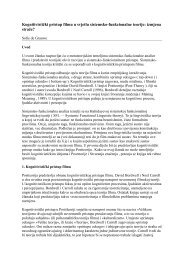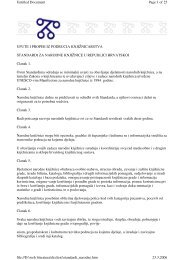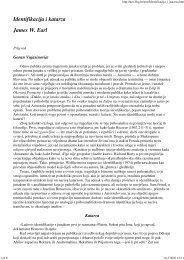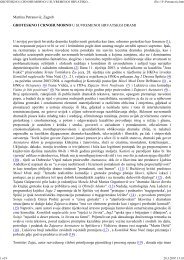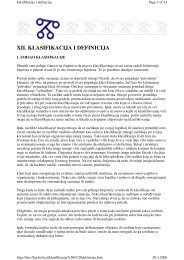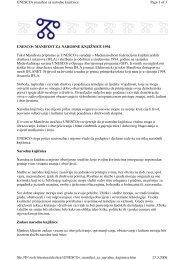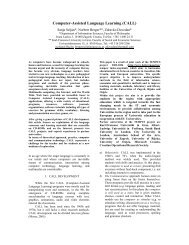Multimedia in Foreign Language Learning
Multimedia in Foreign Language Learning
Multimedia in Foreign Language Learning
Create successful ePaper yourself
Turn your PDF publications into a flip-book with our unique Google optimized e-Paper software.
<strong>Multimedia</strong> <strong>in</strong> <strong>Foreign</strong> <strong>Language</strong> Learn<strong>in</strong>gZ. Dovedan, S. Seljan, K. VučkovićDepartment of Information SciencesFaculty of PhilosophyI.Lučića 3, Zagreb, CroatiaPhone-fax: 01/ 6002-431 E-mail: zdovedan@hotmail.com, sseljan@ffzg.hr, krivucko@yahoo.comAbstract: Computer technology and Internet are <strong>in</strong>evitablenew media <strong>in</strong> education methodology. Still, the central role<strong>in</strong> teach<strong>in</strong>g belongs to humans. The power of Internet lies<strong>in</strong> offer<strong>in</strong>g authentic materials, software, education plans,list of exams, literature, etc. to schools, universities, and<strong>in</strong>stitutions all over the world but under the sameconditions. Next to its commercial importance, it is seen aspedagogical tool for either the <strong>in</strong>dependent research orteamwork.The paper br<strong>in</strong>gs out positive and negative effects of newtechnology and its implementation <strong>in</strong> foreign languageI. INTRODUCTIONToday, more than ever, advancements <strong>in</strong>technology <strong>in</strong>fluence our jobs, education, scientificdevelopment, market and political cooperations,communications, etc. Information and communicationtechnologies have entered every aspect of our lives.Computers are no longer <strong>in</strong>tended for the selected fews<strong>in</strong>ce they exist <strong>in</strong> all forms of contemporary life, andthus <strong>in</strong>clud<strong>in</strong>g educational <strong>in</strong>stitutions as well.Every day, we face the <strong>in</strong>f<strong>in</strong>ity of <strong>in</strong>formationthat needs to be selected among many and thenappropriately used. Computer technology has become apart of every-day activities <strong>in</strong> such an amount thatpresent generations must be computer literate no matterwhat his/her expert of scientific field might be. Such asituation <strong>in</strong>troduces an idea of on-l<strong>in</strong>e web-basedcurricula <strong>in</strong> order to respond to <strong>in</strong>creas<strong>in</strong>g demands fromsociety and <strong>in</strong>dustry the same.In spite of the fact that computers are be<strong>in</strong>gused for education purposes for the past decades, theirusage still does not suffice.Introduction of Internet speeds up the usage ofnew technologies even more and reconsiders the socialrole of educational <strong>in</strong>stitutions. Accord<strong>in</strong>g to someresearch done by the American Technology EvaluationOffice (Wellburn, 1996), the technology should be oneof the major factors for bridg<strong>in</strong>g over larger and largergap between schools and society. Onl<strong>in</strong>e environmentsand the use of the Web have been seen as an educationalpanacea for provid<strong>in</strong>g students with skills such as onl<strong>in</strong>ecommunication, discussion and negotiation of mean<strong>in</strong>g.The new technology helps the teacher with theeducational process, presents new possibilities ofcreative work and two way communication, andfurthermore presents teachers with a challenge toprovide an active participation of all students.Browsers with <strong>in</strong>terest<strong>in</strong>g graphical designs,enable key word search for not only textual pages, butlearn<strong>in</strong>g. Besides for the lessons learn<strong>in</strong>g, the idea of<strong>in</strong>formation literacy ma<strong>in</strong>ta<strong>in</strong>s crucial position <strong>in</strong>education. The new technology demands <strong>in</strong>vestment oftime, effort, money, and self-education, so that thepr<strong>in</strong>cipal question rema<strong>in</strong>s: Are we ready for new type ofeducation <strong>in</strong> order to offer better teach<strong>in</strong>g, more<strong>in</strong>terest<strong>in</strong>g lessons and more importantly, to prepare newgenerations for future challenges?also search for pictures and sounds as well. Usage of e-mails also enables active participation <strong>in</strong> discussion listswhere all participants can discuss, give their op<strong>in</strong>ions orask for help. Data transfer permits transmission ofpictures, sounds, texts or programs needed for theclassroom work. Electronic newspapers and search ofdistant libraries are also different and excit<strong>in</strong>g ways ofgett<strong>in</strong>g required <strong>in</strong>formation.Today, computer technology and Internet needto be seen as unavoidable teach<strong>in</strong>g materials that providestudents with new ways of communication, differentways to access the authentic materials, <strong>in</strong>itiative to<strong>in</strong>dividual research and also to the <strong>in</strong>dividual and teamwork. The ma<strong>in</strong> question today is no longer 'Does theneeded technology exist?' but rather 'Are the educatorsready for the new educational era, for further selfeducation and for putt<strong>in</strong>g more effort and time <strong>in</strong> theirpreparations so that they can offer more <strong>in</strong>terest<strong>in</strong>glessons and more importantly, to prepare presentgenerations for future challenges?’II. MULTIMEDIA USAGE INSCHOOL SETTINGS<strong>Multimedia</strong> can be used for teach<strong>in</strong>g differenttopics <strong>in</strong> math, <strong>in</strong>formatics, foreign language learn<strong>in</strong>g,biology, chemistry, etc. There is an immense quantity ofweb pages with already made materials that can be used<strong>in</strong> the classroom and that cover almost all subjectscovered <strong>in</strong> primary and secondary schools, as well as thematerials for the youngest and the oldest students aswell. So, for example, if you visit FunBra<strong>in</strong>.com, Quia,GetSmarter.org and similar sites, you will f<strong>in</strong>d all sortsof exercises, drills, games, tests, and explanations thatcan be used <strong>in</strong> the classroom. The pages offer differentmaterials for students, accord<strong>in</strong>g to their age group, butalso for teachers and parents.Many conferences and associations concern<strong>in</strong>gthis field, speak about the importance of the newtechnology usage <strong>in</strong> the educational process. Here we
can mention only some like Computer Assisted<strong>Language</strong> Instruction Consortium (CALICO), EuropeanAssociation for Computer Assisted Learn<strong>in</strong>g(EUROCALL), <strong>Foreign</strong> <strong>Language</strong> Learn<strong>in</strong>g Educationand Technology (FLEAT), International Association for<strong>Language</strong> Learn<strong>in</strong>g and Teach<strong>in</strong>g (IALL).Teachers' reaction to the Internet usage variesfrom those who strongly oppose it as a place with toomuch, chaotically organized <strong>in</strong>formation, to those whouncritically embrace it. Both reactions produce equallynegative results and should be changed. In spite of thegreat potentials that Internet offers <strong>in</strong> the languageclassroom, its effectiveness depends on the way bothteachers and students exploit it.It has been proved that students generally enjoywork<strong>in</strong>g with computers, and this fact should be used tomotivate them dur<strong>in</strong>g learn<strong>in</strong>g process. They should bethought how to use Internet as a learn<strong>in</strong>g material asonce they were thought how to use books.III.METHODOLOGY OFMULTIMEDIA SYSTEMS<strong>Multimedia</strong> as teach<strong>in</strong>g material presents a newmethod <strong>in</strong> educational process <strong>in</strong> Croatia's schools.These educational packages consist of different forms ofknowledge. Depend<strong>in</strong>g on their design, they can be usedfor several class periods, for one semester or for even anentire school year. On one hand, these packages maketeachers' job easier, especially for the teachers work<strong>in</strong>g<strong>in</strong> dislocated schools, but on the other hand, they requirespecial computer equipment, computer literacy ofteachers as well as students, and great motivation.<strong>Multimedia</strong> packages comb<strong>in</strong>e differentthematic areas: the ma<strong>in</strong> theme, i.e., the context onwhich the language learn<strong>in</strong>g is based upon, grammar,written and spoken communication. Teachers also needto <strong>in</strong>clude multimedia packages <strong>in</strong> their lesson microplans, and then decide on the class type, plan the topicand doma<strong>in</strong> of the material that will be covered, timeneeded to complete the assignments, the ma<strong>in</strong> objectivesof the class, test<strong>in</strong>g, and other.Usage of the multimedia packages requirescerta<strong>in</strong> teach<strong>in</strong>g aims to be satisfied: educational – acquisition of the new; behavioral – learn<strong>in</strong>g good manners,communication, motivation, self-perception,self-responsibility; functional – f<strong>in</strong>e-tun<strong>in</strong>g of reason<strong>in</strong>g, practic<strong>in</strong>gmemoriz<strong>in</strong>g, observ<strong>in</strong>g, and draw<strong>in</strong>g skills.Contemporary methodology has an accent on the usageof different forms of teach<strong>in</strong>g believ<strong>in</strong>g that it br<strong>in</strong>gs thebest effects, and thus suggests the comb<strong>in</strong>ation offrontal, group, pair and <strong>in</strong>dividual work. If multimedia isadequately <strong>in</strong>cluded <strong>in</strong> such a teach<strong>in</strong>g, it givesextremely good results.A. StrategiesAnita Wenden def<strong>in</strong>es learn<strong>in</strong>g strategies as mentalsteps that learners use to learn a new language andregulate efforts to do so. She also believes that there areonly two ma<strong>in</strong> k<strong>in</strong>ds of learn<strong>in</strong>g strategies that aredist<strong>in</strong>guished on the basis of their function <strong>in</strong> learn<strong>in</strong>g: Cognitive strategies – steps taken to processl<strong>in</strong>guistic and sociol<strong>in</strong>guistic content and they<strong>in</strong>clude select<strong>in</strong>g <strong>in</strong>formation from <strong>in</strong>com<strong>in</strong>gdata, comprehend<strong>in</strong>g it, stor<strong>in</strong>g it, andretriev<strong>in</strong>g it for the use; Self-management strategies – steps taken tooversee and manage learn<strong>in</strong>g and they <strong>in</strong>cludeplann<strong>in</strong>g, monitor<strong>in</strong>g and evaluation.Julika Matravers however makes a different division anduses six k<strong>in</strong>ds of strategies that are used <strong>in</strong> teach<strong>in</strong>gprocess: Cognitive apprenticeship – watch<strong>in</strong>g an expert<strong>in</strong> action and ask<strong>in</strong>g questions; Successive ref<strong>in</strong>ement – the learn<strong>in</strong>g material isexpla<strong>in</strong>ed <strong>in</strong> steps with gradual addition ofdetails; Practice – presentation of a problem that needsto be solved; Demonstration – presentation of example; Socratic h<strong>in</strong>t<strong>in</strong>g – plac<strong>in</strong>g the user <strong>in</strong> a specificframe of m<strong>in</strong>d by provid<strong>in</strong>g short rem<strong>in</strong>ders orquestions; Analogue reason<strong>in</strong>g – present<strong>in</strong>g a differentviewpo<strong>in</strong>t of a situation.The strategy is selected accord<strong>in</strong>g to the subject area andhas to be supported by the <strong>in</strong>terface used <strong>in</strong> theclassroom.IV.MULTIMEDIA IN FOREIGNLANGUAGE LEARNINGInformation and communication technologies areprobably the most used technologies for foreignlanguage teach<strong>in</strong>g. There is probably no teacher who,next to the standard text books, does not br<strong>in</strong>g authenticmaterials, like city maps, newspaper articles, bookreviews, recipes, poems, etc., to his/her classroom. All ofthese and even more can be found on the Internet.Just by us<strong>in</strong>g search eng<strong>in</strong>es on the web, one canaccess far away libraries, f<strong>in</strong>d the on-l<strong>in</strong>e magaz<strong>in</strong>es thatcover specific topics, send massages, discuss problems,or ask for help. This shows that the new technology isnot only a technical help<strong>in</strong>g tool, but an educationallyrich source for the teachers and their students.The web pages that offer different activities forstudents are considered to be very valuable as a sourcefor different: grammar exercises comprehension read<strong>in</strong>g exercises writ<strong>in</strong>g of abstracts and letters solv<strong>in</strong>g puzzles vocabulary learn<strong>in</strong>g through recipes, fashionand sport articles <strong>in</strong>formation on study<strong>in</strong>g abroad search<strong>in</strong>g for jobs or for a certa<strong>in</strong> product translation between languages and many more.In this way, students practice their writ<strong>in</strong>g skills,they search for the th<strong>in</strong>gs of their own <strong>in</strong>terest and thuslearn<strong>in</strong>g becomes more fun. Except for the primary aim,
which is learn<strong>in</strong>g foreign language, students are alsowork<strong>in</strong>g on their computer skills and new technologyusage.As German philosopher, Alexander von Humboldthas noticed 'A language cannot be taught. One can onlycreate conditions for learn<strong>in</strong>g to take place.' and by us<strong>in</strong>gmultimedia, one certa<strong>in</strong>ly creates such conditions.All n<strong>in</strong>e approaches to language teach<strong>in</strong>g that were usedthrough out the history, grammar-translation approach,direct approach, read<strong>in</strong>g approach, audiol<strong>in</strong>gualism,situational approach, cognitive approach, affectivehumanisticapproach, comprehension-based approach,and communicative approach are only brought together<strong>in</strong> multimedia and web usage. This is someth<strong>in</strong>g thatevery teacher needs to have <strong>in</strong> m<strong>in</strong>d when ponder<strong>in</strong>gover us<strong>in</strong>g multimedia or not.A. Examples of <strong>Multimedia</strong> on WWWLearn<strong>in</strong>g with the help of multimedia packages isno longer a one-way process, but rather a dialog amongthe participants. Most often, students use multimedia<strong>in</strong>dividually or <strong>in</strong> pairs, <strong>in</strong> the classroom, and also athome. Work<strong>in</strong>g with such packages, studentssystematize lessons, revise through games, and logicallyconnect learn<strong>in</strong>g materials with real life situations.Next to the multimedia packages on CD-ROMs orfloppy discs, variety of exercises, drills and examplescan be found on the Internet, usually under theEducation category. Except for the ma<strong>in</strong> portals(www.yahoo.com, www.google.com, www.excite.com,...) with Education as a subcategory, there are also directl<strong>in</strong>ks to specialized pages for foreign language learn<strong>in</strong>g,like Education Resources Website(http://www.eduf<strong>in</strong>d.com/), <strong>Language</strong> on the Web(http://www.languages-on-the-web-com), On-l<strong>in</strong>eDictionaries (http://www.yourdictionary.com), <strong>Foreign</strong><strong>Language</strong> Resources on the Web(http://www.itp.berkeley.edu/~thorne/HumanResources.html), and many others.There are multimedia packages <strong>in</strong>tended for earlylearn<strong>in</strong>g (up to ten year old ones) that offer story tell<strong>in</strong>g,song listen<strong>in</strong>g, and game play<strong>in</strong>g which are moreappropriate forms of learn<strong>in</strong>g for that age group. CD-ROMs and Web pages(http://www.enchantedlearn<strong>in</strong>g.com/Dictionary.html,http://www.pdictionary.com) with picture dictionariescan also be found and used for these learners.<strong>Multimedia</strong> packages for older learners differ <strong>in</strong> theircontent and presentation, but nevertheless, offerdynamical, <strong>in</strong>terest<strong>in</strong>g, multimedia environment, withdifferent topics to cover, many types of exercises anddrills, tests, grammatical rules expla<strong>in</strong>ed and used onseveral levels, and last but not the least, feedback to theuser about his progress.V. EVALUATION CRITERIADifferent criteria are mentioned throughout theliterature concern<strong>in</strong>g the evaluation of multimediapackages. Among them, there are few that can be viewedas the major ones that need to be taken <strong>in</strong>toconsideration so that their form, strategy and proceduresmake a system that can be employed <strong>in</strong> education.Accord<strong>in</strong>g to Richard and Janice Schreck three majorevaluations must take place: evaluation of content and <strong>in</strong>structional presentation; evaluation of the smoothness of the learn<strong>in</strong>gexperience; evaluation of the courseware's value <strong>in</strong> thecurriculum.<strong>Multimedia</strong> <strong>in</strong>terfaces for educational systems alsohave to be adjusted to the user – student, concern<strong>in</strong>ghis/her <strong>in</strong>dividual needs, already obta<strong>in</strong>ed results, test<strong>in</strong>gand topics. Criteria that every <strong>in</strong>terface needs to satisfyare: cognitive load and style which <strong>in</strong>clude consistency,abstraction, fidelity, and flexibility; supportiveness which is a right level of feedback orhelp for the user to feel comfortable with theprogram; acceptability which refers to the ability of thesystem to be simple to use, not to cause tiredness,frustration or any discomfort.<strong>Multimedia</strong> <strong>in</strong>terfaces that are used for educationalpurposes are aimed toward the user who needs toefficiently complete his/her assignment. So, next to thealready mentioned criteria, the <strong>in</strong>terface must support thelearn<strong>in</strong>g process <strong>in</strong> a way that the user <strong>in</strong>terface is seenas the student <strong>in</strong>terface s<strong>in</strong>ce the context of <strong>in</strong>teractionbetween a computer and a student is a different one ofthe <strong>in</strong>teraction between a computer and a user.A. Example of <strong>Multimedia</strong> Package on CD-ROM<strong>Multimedia</strong> Package Learn to SpeakFrench/English is one of multimedia packages that unifythematic units with dynamic and static pictures andsounds. Next to lessons, it offers grammar exercises,vocabulary drills, tests, grammar rules, soundrecord<strong>in</strong>gs, listen<strong>in</strong>g of the native speaker with thepossibility of a feed-back.Students usually use these packages <strong>in</strong>dividually or<strong>in</strong> pairs, outside the classroom area. By work<strong>in</strong>g on suchmultimedia package, the student systemizes lessons,reviews through the game, establishes new logicalconnections between the learned material and real lifesituation and thus justifies the teacher’s <strong>in</strong>vestment oftime and effort.There are, also, multimedia packages for earlylanguage acquisition (up to 10 years) that enable storywrit<strong>in</strong>g, game play<strong>in</strong>g, and song listen<strong>in</strong>g.Some CD-ROMs have picture dictionaries withanimations (movement and sound), that children can use<strong>in</strong>dividually, <strong>in</strong> pairs or <strong>in</strong> group. Such CD is PictureDictionary CD-ROM.B. Personalization of <strong>Multimedia</strong> PackagesOne of the criteria of multimedia package is theability to personalize it. S<strong>in</strong>ce the central role belongs to
a student as an <strong>in</strong>dividual, it is important to be able toadopt the program for his/her personal needs. Thestudent can repeat exercises at his/her own will, movethrough the program at his/her own pace and accord<strong>in</strong>gto his/her <strong>in</strong>terests, broaden the lesson us<strong>in</strong>g l<strong>in</strong>ks andadditional texts, evaluate him/herself through record<strong>in</strong>gof his/her own speech, check the test results or exit theprogram <strong>in</strong> every moment. This way, learn<strong>in</strong>g becomes atwo-way communication <strong>in</strong>stead of one-way as it used tobe.The package can be placed on web-site of thespecific class, together with the l<strong>in</strong>ks to other similarpackages.VI.ADVANTAGES ANDDISADVANTAGESThe Internet is only one of the possible uses ofcomputer technology but is still the most disputed andthe most praised one. For some, it as a confirmation ofthe dom<strong>in</strong>ance of American ideas, and for others, avictory of globalization and free market. Someemphasize a user and his/her writes, and someemphasize the idea that the Internet is lead<strong>in</strong>g us towardsalienation and communication breakdown. We oftenhear about the variety of easily accessible <strong>in</strong>formationand knowledge, but also about unsatisfactory generalculture and lack of education.We f<strong>in</strong>d similar reactions concern<strong>in</strong>g the Internetusage <strong>in</strong> the process of education. Some of theadvantages that are usually given as a vote for us<strong>in</strong>gInternet are: 24 hour access to materials; all data can be easily changed, edited or added; data can be exchanged and compared amongdifferent users; learn<strong>in</strong>g is with more enthusiasm that leads tofaster memoriz<strong>in</strong>g of new materials; communication can be led outside the spaceand time that <strong>in</strong>volves school as a centrallearn<strong>in</strong>g place; exercises and drills are adjusted to differentlevels of knowledge; develop<strong>in</strong>g of new technology usage skills; develop<strong>in</strong>g skills for <strong>in</strong>dividual research andteam work; acquisition of social awareness;Of course, there are at the same time disadvantages thatwe should be aware of and that we should keep <strong>in</strong> m<strong>in</strong>dwhen prepar<strong>in</strong>g the Internet materials for the classroomusage: lack of a person <strong>in</strong> charge of the <strong>in</strong>formation wef<strong>in</strong>d on the Internet; easy access to unsuitable content; surf<strong>in</strong>g the web dur<strong>in</strong>g and after the class timefor the materials not connected with thelearn<strong>in</strong>g process; virus threat.In spite of these negative sides of the Internet usage,they should not be seen as a threat to us<strong>in</strong>g it at all.Teachers should have a central role here and with his/herchoice of decisions use new technologies and Internet toenrich teach<strong>in</strong>g process <strong>in</strong> multiple ways.VII.CONCLUSIONInternet and Web provide new forms ofcommunication and thus br<strong>in</strong>g many possibilities, butalso make their demands for permanent education, usage<strong>in</strong> classroom, cultural spread<strong>in</strong>g, scientific education andeconomic development. The new technology has to beseen as a possibility of a new k<strong>in</strong>d of communicationand as a help to a teacher whose role stays irreplaceable.Teachers should be placed <strong>in</strong> the role offacilitator whose task is to develop and ma<strong>in</strong>ta<strong>in</strong>supportive class atmosphere. They will always be theones who decide, direct, expla<strong>in</strong>, connect old with thenew, recognize nonverbal communication, and givemoral support. Communication between a teacher and astudent, and among students themselves, must not belost. That is why it is important to adequately usetechnology and Internet <strong>in</strong> the classroom and make surethat alienation does not take place at any cost. Directedand wisely managed teach<strong>in</strong>g should only profit by theuse of computer technology.The ability of multimedia packages to motivatestudents should be used to do exactly that. They can onlybe seen as the help<strong>in</strong>g tool for the classical teach<strong>in</strong>gprocess, and the variety and flexibility that they offershould be used to br<strong>in</strong>g out the best that students cangive.LITERATURE[1] M. D. Bush, <strong>Language</strong> Learn<strong>in</strong>g Via the Web. Symposiumof the Computer Aided <strong>Language</strong> Instruction Consortium,Albuquerque, 1996.http://moliere.byu.edu/calico/calico98.html[2] M. Celce-Murcia (ed.), Teach<strong>in</strong>g English as a Second or<strong>Foreign</strong> <strong>Language</strong>, He<strong>in</strong>le & He<strong>in</strong>le Publishers,Massachusetts, 1991.[3] J. H. Hulstijn, The Use of Computer Technology <strong>in</strong>Experimental Studies of Second <strong>Language</strong> Acquisition: ASurvey of Some Techniques and Some Ongo<strong>in</strong>g Studies,<strong>Language</strong> Learn<strong>in</strong>g & Technology, Vol 3, No 2, 2000.http://llt.msu.edu/vol3num2/hulstijn/<strong>in</strong>dex.html[4] <strong>Language</strong> Learn<strong>in</strong>g Activities for the World Wide Web,http://polyglot.lss.wisc.edu/lss/lang/nflrc.html.[5] <strong>Language</strong>, Education and Technology,http://kloatu.oit.umass.edu/langctr/langlearn.html.[6] J. Matravers. '<strong>Multimedia</strong> Interfaces for EducationalSystems', Journal of Comput<strong>in</strong>g and Information Technology –CIT 6, p. 325, 1998.[7]D. Mills, Computers <strong>in</strong> <strong>Language</strong> Learn<strong>in</strong>g: Possible Roles.http://deil.lang.uius.edu/resources/possible.roles.[8] D. B. Paulston, M.N. Bruder, Teach<strong>in</strong>g English as aSecond <strong>Language</strong>: Techniques and Procedures, W<strong>in</strong>thropPublishers, Inc. Massachusetts, 1976.[9] A. Wenden, Learn<strong>in</strong>g Strategies for Learner Autonomy,Prentice Hall Europe, 1998.[10] S. W<strong>in</strong>deatt, D. Hardisty, D. Eastment, The Internet,Oxford University Press, 2000.



